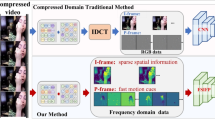Abstract
This paper introduces a new compression scheme that exploits temporal redundancies in video segments utilizing the pixogram concept recently introduced in the literature. By taking into consideration the correlation between video pixels along the time domain, a pixogram has the ability to transform uncorrelated spatial areas of separate video-frames into highly correlated temporal vectors, thus increasing redundancy in the transform domain. This strategy allows for higher compression ratios in video streams. The proposed compression scheme is the first compression technique that utilizes the pixogram concept in video compression, and aims to challenge the traditional trade-off associated with high compression ratios leading to reduced visual quality. Comparisons with popular compression standards demonstrate the advantage this new approach has for highly correlated video segments. Moreover, the proposed technique is more suitable to parallelization, and thus outperforms other compression techniques in terms of execution time.










Similar content being viewed by others
References
Baziyad M, Rabie T, Kamel I (2018) Extending steganography payload capacity using the L*a*b* color space. In: 2018 International conference on innovations in information technology (IIT’18). IEEE, pp 1–6
Boyadjis B, Bergeron C, Pesquet-Popescu B, Dufaux F (2017) Extended selective encryption of h. 264/avc (cabac)-and hevc-encoded video streams. IEEE Trans Circ Syst Video Technol 27(4):892–906
Deutsch P, et al. (1996) Rfc 1951 deflate compressed data format specification version 1.3. Network Working Group, 15
Grois D, Marpe D, Mulayoff A, Itzhaky B, Hadar O (2013) Performance comparison of h. 265/mpeg-hevc, vp9, and h. 264/mpeg-avc encoders. In: 2013 Picture coding symposium (PCS). IEEE, pp 394–397
Le LN, Nguyen ST, Nguyen NX, Dang TT (2017) A principle of adaptively grouping frames on lossless medical video compression using ideal cross-point regions. In: International conference on the development of biomedical engineering in Vietnam. Springer, pp 19–23
Lewis A, Knowles G (1990) Video compression using 3d wavelet transforms. Electron Lett 26(6):396–398
Martini MG, Hewage CT, Villarini B (2012) Image quality assessment based on edge preservation. Signal Process Image Commun 27(8):875–882
Mukherjee D, Bankoski J, Grange A, Han J, Koleszar J, Wilkins P, Xu Y, Bultje R (2013) The latest open-source video codec vp9-an overview and preliminary results. In: Picture coding symposium (PCS), 2013. IEEE, pp 390–393
Nguyen TQ, et al. (2008) Quality enhancement for motion jpeg using temporal redundancies. IEEE Trans Circ Syst Video Technol 18(5):609–619
Pudlewski S, Cen N, Guan Z, Melodia T (2015) Video transmission over lossy wireless networks: a cross-layer perspective. IEEE J Selected Topics Signal Process 9(1):6–21
Rabie T (2017) Color-secure digital image compression. Multimed Tools Appl 76(15):16657–16679
Rabie T, Baziyad M (2017) Visual fidelity without sacrificing capacity: an adaptive Laplacian pyramid approach to information hiding. J Electron Imag 26(6):063001
Rabie T, Baziyad M (2019) The pixogram: addressing high payload demands for video steganography. IEEE Access 7:21948–21962. https://doi.org/10.1109/ACCESS.2019.2898838
Rabie T, Kamel I (2016) On the embedding limits of the discrete cosine transform. Multimed Tools Appl 75(10):5939–5957
Rabie T, Kamel I (2017) High-capacity steganography: a global-adaptive-region discrete cosine transform approach. Multimed Tools Appl 76(5):6473–6493
Rabie T, Kamel I (2017) Toward optimal embedding capacity for transform domain steganography: a quad-tree adaptive-region approach. Multimed Tools Appl 76 (6):8627–8650
Rabie T, Baziyad M, Kamel I (2018) Enhanced high capacity image steganography using discrete wavelet transform and the Laplacian pyramid. Multimed Tools Appl, 1–26
Rabie T, Baziyad M, Kamel I (2019) High payload steganography: surface-fitting the transform domain. In: 2019 International conference on communications, signal processing, and their applications (ICCSPA). IEEE, pp 1–6
Rabie T, Kamel I, Baziyad M (2018) Maximizing embedding capacity and stego quality: curve-fitting in the transform domain. Multimed Tools Appl 77(7):8295–8326
Ravi A, Rao K (2011) Performance analysis and comparison of the dirac video codec with h. 264/mpeg-4 part 10 avc. Int J Wavelets Multiresol Inform Process 9 (04):635–654
Santos L, Lopez S, Callico GM, Lopez JF, Sarmiento R (2012) Performance evaluation of the h. 264/avc video coding standard for lossy hyperspectral image compression. IEEE Jof Selected Topics Appl Earth Observ Remote Sens 5 (2):451–461
Servais M, De Jager G (1997) Video compression using the three dimensional discrete cosine transform (3d-dct). In: Proceedings of the 1997 South African symposium on communications and signal processing, 1997. COMSIG’97. IEEE, pp 27–32
Srinivasan S, Hsu PJ, Holcomb T, Mukerjee K, Regunathan SL, Lin B, Liang J, Lee M-C, Ribas-Corbera J (2004) Windows media video 9: overview and applications. Signal Process Image Commun 19(9):851–875
Tekalp AM (2015) Digital video processing. Prentice Hall Press
Xiao F, et al. (2000) Dct-based video quality evaluation. Final Project for EE392J, 769
Author information
Authors and Affiliations
Corresponding author
Additional information
Publisher’s note
Springer Nature remains neutral with regard to jurisdictional claims in published maps and institutional affiliations.
Rights and permissions
About this article
Cite this article
Rabie, T., Baziyad, M. PixoComp: a novel video compression scheme utilizing temporal pixograms. Multimed Tools Appl 79, 13179–13196 (2020). https://doi.org/10.1007/s11042-020-08660-9
Received:
Revised:
Accepted:
Published:
Issue Date:
DOI: https://doi.org/10.1007/s11042-020-08660-9




